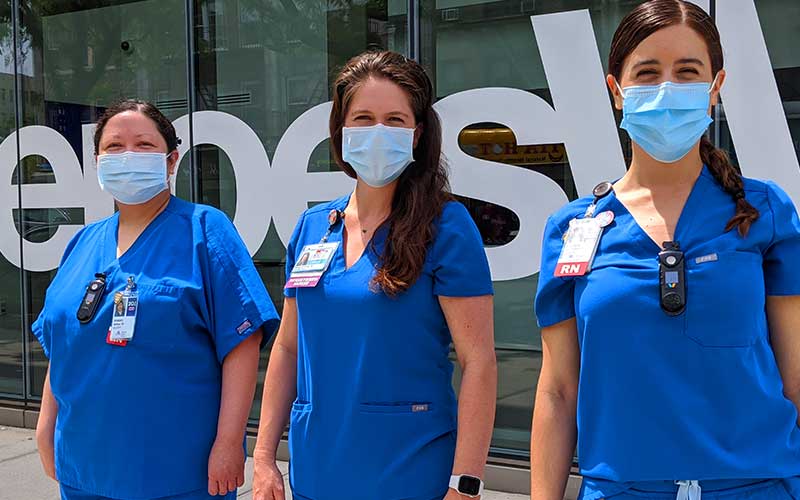Testing Early for Viral Load May Lead to Better Care for Patients with COVID-19

Carlos Cordon-Cardo, MD, PhD
The more SARS-CoV-2 virus, or viral load, individuals have in their bodies, the greater their chances of dying of COVID-19. This association was borne out in a new study at the Icahn School of Medicine at Mount Sinai that was led by Carlos Cordon-Cardo, MD, PhD, the Irene Heinz Given and John LaPorte Given Professor and Chair of the Lillian and Henry M. Stratton-Hans Popper Department of Pathology, Molecular and Cell-Based Medicine.
Dr. Cordon-Cardo and his team measured the viral load of 1,145 patients with COVID-19 who were admitted to the Mount Sinai Health System between March 13 and May 5, during the height of the pandemic in New York. These patients had an overall mortality rate of 29.5 percent. When the researchers adjusted for age, sex, and race, and comorbidities such as asthma, heart disease, hypertension, and chronic obstructive pulmonary disease, they found that a higher viral load was still associated with a significantly higher mortality rate.
Based on such a strong correlation, Dr. Cordon-Cardo and his team would like to see quantitative reporting for viral load added to the polymerase chain reaction (PCR) tests that are used to determine if someone has COVID-19. Right now, PCR tests provide a yes or no answer: either someone has or doesn’t have COVID-19. Determining an individual’s viral load would add another layer of knowledge and could be easily implemented by most testing facilities. PCR tests differ from antibody tests that establish whether someone has recovered and may now have some level of immunity.

The chart demonstrates a significant mortality difference between hospitalized patients with high and low SARS-CoV-2 viral load.
“At the beginning of the disease this is the first test you’re going to get, and more viral presence means a more aggressive disease,” says Dr. Cordon-Cardo. “Chances are you are going to get a lot sicker. Taking Tylenol and staying home is probably not going to be enough to help you.” If doctors are aware of a patient’s viral load, they would be prepared to help the patient remotely or admit them to the hospital for observation and, perhaps, early antiviral treatment. Clinicians would have the opportunity to treat the disease at its earliest stage, the best opportunity to prevent it from becoming more destructive.
The amount of virus individuals have in their body could also determine how much they are able to spread the disease to others. Early quarantining of these “superspreaders” would help protect others. Quantitative testing for viral load is relatively quick and inexpensive, according to Dr. Cordon-Cardo. Results can be obtained in a few hours and easily added to current PCR tests.
Understanding this key differentiator in disease progression is the first step in applying personalized medicine to the standard of care for COVID-19. The study’s first author, Elisabet Pujadas, MD, PhD, a Mount Sinai pathology resident and postdoctoral fellow, says, “Obtaining quantitative results that help guide management for the individual patient is one of the bigger goals here. COVID-19 is unique in that the disease offers many new challenges. People get sick and deteriorate so quickly that it surprises clinicians who are treating them. So it’s hard to know up front who is going to do worse than others.”
Knowing which patient is likely to become sicker would also help hospitals better manage their resources, she says. “This illness is not the same for everyone, and this information has great implications for what the best treatment for each patient may be and how we manage limited resources when there is a big surge of people who need to be cared for.”

Elisabet Pujadas, MD,PhD
Mount Sinai’s Department of Pathology is working closely with the Mount Sinai COVID Informatics Center, which was created in the spring to analyze large amounts of health data among patients with the disease. Together, the groups are developing algorithms based on viral loads, comorbidities, and other clinical values that would help doctors evaluate patients based on individualized data.
“All of this up-front clinical information would help guide us in knowing how infected the patient is, how concerned we should be, and which therapies could help or not so we could do a better job of caring for each patient,” says Dr. Pujadas.
Stratifying patients with COVID-19 would follow the same paradigm of care that has already been established for patients with HIV or cancer who receive personalized medicine.
“The more virus you have, the more virus is going to travel in your blood vessels, like cancer cells. And it happens that certain vessels have receptors to the virus that are hospitable,” says Dr. Cordon-Cardo. “In individuals who already have vascular damage you are now adding another condition and the patient is at much higher risk of getting worse. COVID-19 is different diseases at different moments. We should be able to apply the right treatments and the right management for the patient with the knowledge we are obtaining.”











